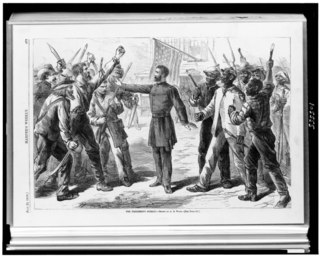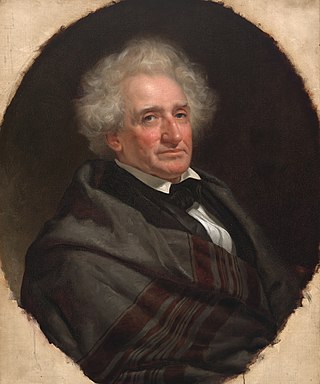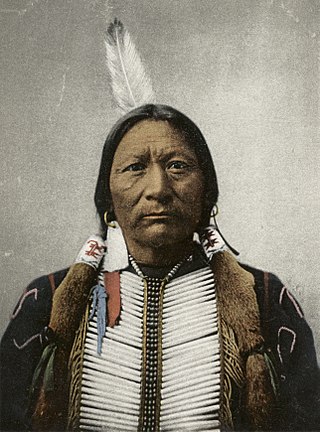Related Research Articles

The Chickasaw are an Indigenous people of the Southeastern Woodlands, United States. Their traditional territory was in northern Mississippi, northwestern and northern Alabama, western Tennessee and southwestern Kentucky. Their language is classified as a member of the Muskogean language family. In the present day, they are organized as the federally recognized Chickasaw Nation.

The Pomo are a Native American people of California. Historical Pomo territory in Northern California was large, bordered by the Pacific Coast to the west, extending inland to Clear Lake, mainly between Cleone and Duncans Point. One small group, the Tceefoka, lived in the vicinity of present-day Stonyford, Colusa County, were they were separated from the majority of Pomo lands by Yuki and Wintuan speakers.

The Bureau of Refugees, Freedmen, and Abandoned Lands, usually referred to as simply the Freedmen's Bureau, was a U.S. government agency of early post American Civil War Reconstruction, assisting freedmen in the South. It was established on March 3, 1865, and operated briefly as a federal agency after the War, from 1865 to 1872, to direct "provisions, clothing, and fuel... for the immediate and temporary shelter and supply of destitute and suffering refugees and freedmen and their wives and children".

The Bureau of Indian Affairs (BIA), also known as Indian Affairs (IA), is a United States federal agency within the Department of the Interior. It is responsible for implementing federal laws and policies related to Native Americans and Alaska Natives, and administering and managing over 55,700,000 acres (225,000 km2) of reservations held in trust by the U.S. federal government for indigenous tribes. It renders services to roughly 2 million indigenous Americans across 574 federally recognized tribes. The BIA is governed by a director and overseen by the Assistant Secretary for Indian Affairs, who answers to the Secretary of the Interior.
The Shoshone or Shoshoni are a Native American tribe with four large cultural/linguistic divisions:

The Sac and Fox Nation is the largest of three federally recognized tribes of Sauk and Meskwaki (Fox) Indian peoples. Originally from the Lake Huron and Lake Michigan area, they were forcibly relocated to Oklahoma in the 1870s and are predominantly Sauk. The Sac and Fox Oklahoma Tribal Statistical Area (OTSA) is the land base in Oklahoma governed by the tribe.

The Arikara, also known as Sahnish, Arikaree, Ree, or Hundi, are a tribe of Native Americans in South Dakota. Today, they are enrolled with the Mandan and the Hidatsa as the federally recognized tribe known as the Mandan, Hidatsa, and Arikara Nation.

The Kalapuya are a Native American people, which had eight independent groups speaking three mutually intelligible dialects. The Kalapuya tribes' traditional homelands were the Willamette Valley of present-day western Oregon in the United States, an area bounded by the Cascade Range to the east, the Oregon Coast Range at the west, the Columbia River at the north, to the Calapooya Mountains of the Umpqua River at the south.

The history of Washington, D.C., is tied to its role as the capital of the United States. The site of the District of Columbia along the Potomac River was first selected by President George Washington. The city came under attack during the War of 1812 in an episode known as the Burning of Washington. Upon the government's return to the capital, it had to manage the reconstruction of numerous public buildings, including the White House and the United States Capitol. The McMillan Plan of 1901 helped restore and beautify the downtown core area, including establishing the National Mall, along with numerous monuments and museums.

The Fort Laramie Treaty of 1851 was signed on September 17, 1851 between United States treaty commissioners and representatives of the Cheyenne, Sioux, Arapaho, Crow, Assiniboine, Mandan, Hidatsa, and Arikara Nations. Also known as Horse Creek Treaty, the treaty set forth traditional territorial claims of the tribes.

Ute are the indigenous, or Native American people, of the Ute tribe and culture among the Indigenous peoples of the Great Basin. They had lived in sovereignty for several hundred years in the regions of present-day Utah and Colorado.

Thomas Loraine McKenney was a United States official who served as Superintendent of Indian Affairs from 1824–1830.

William Fraser Tolmie was a surgeon, fur trader, scientist, and politician.

The Ute Indian Tribe of the Uinta and Ouray Reservation is a federally recognized tribe of Indians in northeastern Utah, United States. Three bands of Utes comprise the Ute Indian Tribe: the Whiteriver Band, the Uncompahgre Band and the Uintah Band. The Tribe has a membership of more than three thousand individuals, with over half living on the Uintah and Ouray Indian Reservation. The Ute Indian Tribe operates its own tribal government and oversees approximately 1.3 million acres of trust land which contains significant oil and gas deposits.
In United States history, an Indian agent was an individual authorized to interact with American Indian tribes on behalf of the government.
The Oregon Superintendent of Indian Affairs was an official position of the U.S. state of Oregon, and previously of the Oregon Territory, that existed from 1848 to 1873.

Sapiah, is also commonly known as Charles Buck and Buckskin Charley, was the leader of the Southern Ute tribe from about 1870 until his death in 1936. He led a group of Utes to rescue women and children from the White River Agency during the Meeker Massacre (1879) that resulted in the deaths of Nathan Meeker and his soldiers. The northern band of Utes were forced out of Colorado after the massacre.
James Mahlon Haworth was a United States Army major, an Indian agent, and the first Superintendent of Indian Schools in the United States.
Enoch Hoag (1812–1884) was an Indian Agent who was appointed Superintendent of the Central Superintendency in 1869 by President Ulysses S. Grant during his "Peace Policy". His tenure ended after the election of Rutherford B. Hayes. The University of Oklahoma has a collection of his papers. Haverford College also has a collections of his papers.

Juanita L. Learned was the first woman to chair the Cheyenne and Arapaho Tribes. She was Southern Arapaho and was known for her work to keep the Concho Indian School from closing, as well as actions to return the school building, and land and buildings of Fort Reno to her tribe.
References
- 1 2 Superintendency, United States Bureau of Indian Affairs Central (3 December 1972). "Records of the Central Superintendency of Indian affairs: 1813-1878". National Archives, National Archives and Records Service, General Services Administration – via Google Books.
- ↑ Masterson, James R. (3 December 2018). "The Records of the Washington Superintendency of Indian Affairs, 1853-1874". The Pacific Northwest Quarterly. 37 (1): 31–57. JSTOR 40486736.
- ↑ Braund, Kathryn E. (28 March 1996). Deerskins and Duffels: Creek Indian Trade with Anglo-America, 1685-1815. U of Nebraska Press. ISBN 978-0803261266 – via Google Books.
- 1 2 Viola, Herman J. (3 December 1995). Diplomats in Buckskins: A History of Indian Delegations in Washington City. University of Oklahoma Press. ISBN 9780806199351 – via Google Books.
This article needs additional or more specific categories .(April 2023) |